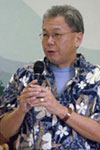
Mr. Damian Bazadona
Winning the Talent War
Posted by Oct 20, 2015

Mr. Damian Bazadona
Every empty seat in a theatre isn't simply lost revenue; it's a lost opportunity to tackle one of the biggest challenges we can expect to face in the arts and culture business today - talent development.
I am not an expert by any means on the process or state of arts funding in America, but I can clearly see the dysfunction in our government at all levels. In today’s education system, there is a significant lack of equity regarding access to a quality arts education, often due to the location of the school.
Read More





 Elias Gross
Elias Gross

 Ariel Fielding
Ariel Fielding

 Janet Starke
Janet Starke


 Jill Robinson
Jill Robinson

 Al Stilo
Al Stilo

 Ann-Laura Parks
Ann-Laura Parks

 Gerald Yoshitomi
Gerald Yoshitomi

 Brianne Logan
Brianne Logan

 Jordan Silton
Jordan Silton

 Chris McLeod
Chris McLeod

 Amelia Northrup-Simpson
Amelia Northrup-Simpson

 Jim McCarthy
Jim McCarthy

 Jeff Poulin
Jeff Poulin

 Over the past few weeks, a new face has been popping up at street fairs and food festivals across the country: an Amazon “food truck,” doling out Kindle Fires alongside neighboring trucks’ hot dogs, hamburgers, and artisanal cupcakes.
Over the past few weeks, a new face has been popping up at street fairs and food festivals across the country: an Amazon “food truck,” doling out Kindle Fires alongside neighboring trucks’ hot dogs, hamburgers, and artisanal cupcakes.
 Sean King
Sean King

 Ron Evans
Ron Evans

 Beth Malone
Beth Malone

 David Dombrosky
David Dombrosky

 Rachel Ciprotti
Rachel Ciprotti

 Aaron Bisman
Aaron Bisman

 Sean Daniels
Sean Daniels

 Rachel Grossman
Rachel Grossman

 Jessyca Holland
Jessyca Holland




